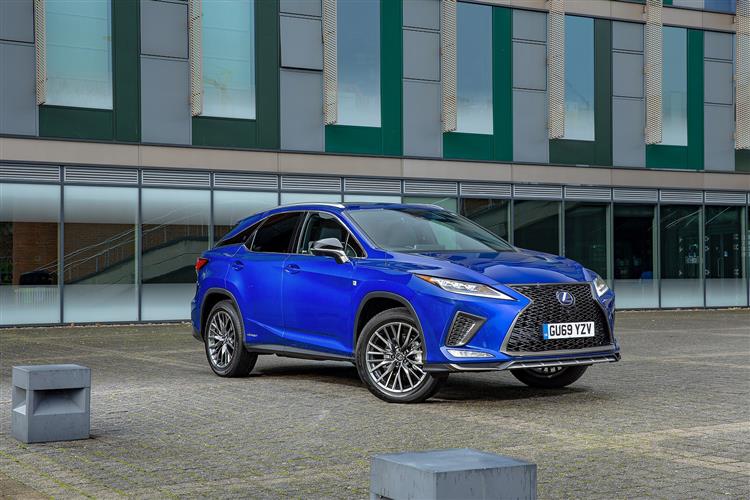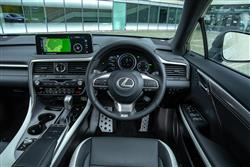How will you view?
This is a sample, showing 30 seconds of each section.
THE LEX-EFFECT (some text hidden) SECTIONED_new_lexusrx_2020
By Jonathan Crouch
Introductionword count: 60
The improved post-2019-era version of this fourth generation Lexus RX got smarter, cleverer and slightly sharper to drive. It's the large luxury SUV that pioneered full-Hybrid power and in this form, the RX continued to use that technology in its most affordable 'self-charging' form as part of a supremely relaxed ownership experience. For target buyers, there's nothing quite like it.
Modelsword count: 5
SUV - 3.5 petrol/electric Hybrid
Historyword count: 436
If ever a category of car cried out for a more efficient means of forward motion, it's the large luxury SUV. In recent times, premium brands in this segment have been falling over themselves to introduce electrified options to meet this need - but Lexus has been doing so with this RX since 2005. Here, we're going to look at the much improved version of the fourth generation design, an update that the brand introduced at the end of 2019. In this form, the RX remained a so-called 'self-charging' full-Hybrid - still the only one in the class; in other words, unlike some rival PHEV and full-Electric models in this segment from this era, you can't plug it in and get any kind of significant electric-only driving range. Back in 2019, Lexus did have access to PHEV tech, but preferred at the time not to use it. The self-charging solution certainly made this model easily the most affordable electrified option in its segment. Which was a key reason why the RX was - and still is - so significant to Lexus, back in 2019 making up a fifth of the brand's global sales, with over three million RX models by then sold to date. The first generation 'XU10'-series model was one of the first premium-badged luxury SUVs in the segment, launched in 1998, and Hybrid power came to the RX with its successor, the MK2 'XU30'-series design, introduced in 2003 and updated with a third generation 'AL 10'-series model in 2008. This fourth generation 'AL 20'-series version was first launched in 2015 and its range expanded with a 7-seat RX L variant in 2018. Both body styles were hugely popular in the US, where this car was usually top of its segment, selling more than double the amount of its closest competitor, the Mercedes GLE. It was a different story in Europe, where RX sales back in 2019 were a quarter of those of two key rivals, the BMW X5 and the Volvo XC90. But with this MK4 model update and the industry's stampede towards electrification, Lexus thought at the time of this facelift that this model's moment on our continent might have come. Hence the wide ranging package of updates for this improved MK4 RX, the model we're going to look at here from a used car perspective. Suspension and steering updates claimed to have improved the handling. There was a clever new BladeScan Adaptive High-Beam headlight system. Plus some extra camera safety kit, important interior infotainment updates and a mild styling refresh. This car sold until the all-new MK5 RX was launched in mid-2022.
What You Getword count: 638
The changes made to this fourth generation 'AL 20'-series RX were subtle but really quite effective, intended to add elegance without diminishing this design's powerful SUV image. If you happen to know this car, probably the most notable change made to this updated post-2019-era model was the way that the appearance of the front 'spindle' grille was brought into line with the way that feature looks on the brand's more recent UX crossover and LC sports car models. There were subtle changes at the rear too - most obviously the re-styled combination tail lamps, which gained a fresh design of four overlapping L motifs. As with the original version of this MK4 RX, there's a body style choice between this standard model or the alternative 7-seat RX L version, which gets an extra 110mm of rear overhang and a more steeply-angled tailgate. Behind the wheel, the distinctively styled interior delivers a driver-centric feel that's refreshingly different from the expensively-crafted SUV simplicity served up by rival German brands. This cabin's exquisitely-trimmed too, but somehow in a more characterful way, with a lovely central analogue clock and leather that's hand-stitched on each RX by a team of 17 'Lexus Takumi' craftspeople to achieve its flawless finish. If you were familiar with the original version of this fourth generation model, the major difference you'll note here is that the fiddly old 'Remote Touch' mouse that used to operate the central infotainment screen has here been dispensed with, but unfortunately replaced by something that's equally awkward to use properly on a bumpy road - a 'Remote Touch' trackpad. It serves the central 12.3-inch 'Lexus Premium Navigation' multimedia screen that in this form, all RX models got, a display that included 'Apple CarPlay'/'Android Auto' smartphone-mirroring. And the rear seat? Well you might be quite surprised just how much headroom there is, given that this bench sits directly on top of the three battery packs that power the Hybrid drive system. Lexus said the leg room on offer here is 'limousine-like', which is a bit of an exaggeration, but you can get very comfortable, helped by the way the seat bases slide and the seat backs recline for greater long distance comfort, using the lower seat base switches. Most will choose the standard RX body shape but as mentioned earlier, there's also an alternative RX L variant with its third row of seating in a separate film. With that derivative, accessing the third row was made easier on this revised model with a one-touch lever control on the outer second row seats which tips the seatback forward and slides the bench smoothly away. In an RX L, the rearmost seats are finished to the same high quality as the rest of the cabin but, as you might expect, are really only intended for kids. They could though, with this facelifted model, be used for adults on shorter trips thanks to changes that Lexus made which allow a third row occupant to slight change the seat position and free up an extra 94mm of leg space. And luggage space?, which you might expect to be slightly compromised by hybrid mechanicals in the way it usually is with rival PHEV models. In the event, the issues aren't too serious. The cargo area is 453-litres in size and was designed from the outset around the needs of the hybrid powertrain. If you need more space, you'll be please to find that the centre part of the rear backrest splits separately so that you can more easily transport longer items like skis. On the top 'Takumi' variant, you get a power-folding mechanism for the main parts of the rear backrest, operated by electrical retraction switches on the right. Use them to retract the bench and though the cargo area created isn't completely flat, it is 924-litre in size.
To see the full road test text contact us on 0330 0020 227
Pictures (high res disabled)

.jpg)
|
.jpg)
|
.jpg)
| |||
.jpg)
|
.jpg)
|
.jpg)
| |||
.jpg)
|
.jpg)
|
.jpg)
| |||

|
Scoring (subset of scores)
Category: Crossover or SUV 4x4s
| Performance | |
| Handling | |
| Comfort | |
| Space | |
| Styling, Build, Value, Equipment, Depreciation, Handling, Insurance and Total scores are available with our full data feed. | |



